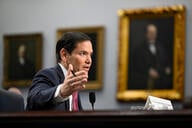You have /5 articles left.
Sign up for a free account or log in.

The University of Arizona is one of many institutions offering faculty temporary bridge funding amid cuts to federal research funding.
Photo illustration by Justin Morrison/Inside Higher Ed | ianmcdonnell/E+/Getty Images | Rawpixel
Colleges and universities are digging into their own pockets to temporarily support graduate students and faculty in limbo after the Trump administration’s sudden cancellation—and stalled review—of billions of dollars in federal research grants.
In February, the Yale School of Medicine began offering temporary funding to researchers with terminated grants—many related to topics the Trump administration has deemed unworthy of scientific inquiry, such as transgender health—to give them time to reorient their research. Yale’s Graduate School of Arts and Sciences is also investing $4 million to support graduate students who have lost training and research grants. Similarly, last month Johns Hopkins University announced that it is tapping earnings from its $13.2 billion endowment to give researchers $100,000 each for delayed grants, or $150,000 for terminated grants, during a 12-month period. And Northwestern University—which hasn’t received any grant payments from the National Institutes of Health since March—is offering faculty up to $50,000 to maintain projects for up to one year.
While institutional funding will help some researchers continue their work in the short term, experts and research advocates say it’s far from a long-term solution. And neither is counting on private industry or philanthropists to step in to sustain the U.S. research enterprise at the same scale federal grants have done over the past 80 years, experts say.
Over the past several decades, universities have already substantially increased the amount of money they spend on their own research and development—from 10 percent of the total in 1970 to 25 percent in 2023, according to federal data. Meanwhile, federal support for academic research has been on the decline, falling from 71 percent to 55 percent during that same timeframe. And support from industry, charities and other sources have always been marginal, collectively making up about 15 percent of contributions to research funding at colleges and universities in 2023.
“When it comes to supporting curiosity-driven scientific research, there is simply no replacement for the federal government,” said Toby Smith, senior vice president for government relations and public policy at the Association of American Universities. “While private industry is critically dependent on the broad-based knowledge and training produced by university-based research, industry tends to focus their own R&D efforts on applied research where they can better guarantee a direct return to the company on their shareholders’ investment.”
Although the Trump administration’s long-range vision for supporting scientific research remains far from clear, colleges are under immediate pressure to fill in some of the federal funding craters that have already upended research—including some clinical trials—on cancer, diabetes and HIV prevention.
And it’s not just the nation’s wealthiest institutions that are launching bridge funding efforts.
The Universities of Hawaii, Massachusetts and Arizona have all announced programs designed to bridge funding gaps and help graduate students stay on track and finish their dissertations, or faculty whose research projects are at risk of disruption.
‘Fuel’ for the Economic Engine
Soon after faculty at the University of Arizona raised concerns about cuts to research funding, officials established a Bridge Funding Investment Program to aid faculty with an established track record of extramural funding, with a particular focus on preserving Ph.D. student support. According to Tomás Díaz de la Rubia, senior vice president for research and innovation, UA—which is still recovering from a budget crisis—has allocated $1 million in bridge funding.
While that won’t cover all of the terminated grants, “the bridge has to go somewhere,” he said, explaining that the program isn’t supporting projects that don’t have viable alternative long-term funding options. Instead, “we’re providing funding for projects where the faculty member has other sources of funding and other proposals with the same or different federal agencies,” Díaz de la Rubia said. “So far, we’ve been able to support every request that we’ve received through this process.”
The bridge programs at Arizona and other universities aren’t intended to indefinitely sustain the academic research enterprise, which is facing the possibility of even deeper funding cuts. Earlier this month, President Trump unveiled his budget proposal for Fiscal Year 2026, which includes gutting the budgets for both the NIH and the National Science Foundation—two of the biggest funders of university research.
Díaz de la Rubia said UA and other universities are already working with local, state and federal lawmakers, as well as companies that rely on university research, to make a case for preserving research funding and the economic benefit it affords taxpayers.
For every $1 the NIH spent on research funding in 2024, it generated $2.56 of economic activity, according to a report by United for Medical Research.
“Congress needs to hear a lot of voices, not just academic voices,” he said. “Without the fuel for the economic engine, there is no engine. And universities are that fuel. We are the ones that create those early-stage discoveries and technologies that get translated into private sector innovations that drive the economy and provide for national security.”
Industry Support ‘Not Realistic’
While big-name technology and pharmaceutical companies bring fully formed inventions to market, those products are typically derived from university-led discoveries. For instance, NIH funded-research contributed to 99 percent of drugs approved between 2010 and 2019, according to the Center for American Progress. And many of the components of smartphones, including touch screens and multi-core processors, have origins in federally funded university research.
In 2023, only 6.8 percent of research expenditures in the United States came from industry, according to data from the Association of University Technology Managers (AUTM).
“A decline in research funding will result in fewer inventions, which means fewer innovations will get to market. The pipeline for innovations is being constrained right now,” said Stephen Susalka, CEO of AUTM, which supports the development of academic research. And since the cuts to research funding come on top of broader budget cuts to higher education institutions, scientists may receive less financial support for their patent applications, preventing private companies from using their inventions. “I imagine that in 10 years, there will be fewer drugs approved than there are today because of these constraints on the front end,” Susalka said.
Ruth Johnston, vice president of the National Association of College and University Business Officers, said that expecting the private sector to support such research in lieu of the federal government may be “idealistic, but it’s not realistic.” Similarly, philanthropic organizations likely can’t replace once-stable federal research support—especially given the market volatility President Trump’s tariff-driven economic agenda has introduced.
“Because the market is so uncertain right now, philanthropic organizations are trying to think of their own financial sustainability,” Johnston said. “They have to be given money from somebody—are people going to want to give at the same levels as they were before?”
And while some philanthropic organizations are stepping in to support research on specific topics—the Bill Gates Foundation said Thursday that it plans to spend $200 billion on researching poverty, infectious diseases and child deaths before it closes in 2045—relying on private donors even when the economy is strong has its drawbacks.
That’s in part because both industry leaders and wealthy do-gooders are driven by their own financial or personal goals, said Christopher Newfield, director of research at the Independent Social Research Foundation in London and professor emeritus of English at the University of California at Santa Barbara.
“The strength of U.S. research has always been that it is researcher-driven, by the people who know best, not by moguls with special interests or axes to grind,” Newfield said in an email. “Firms take fundamental concepts, materials, discoveries mostly uncovered in universities and apply them in product lines that they think have high future value in the marketplace. Usually this needs to be a near-term future—a couple of years. Fundamental research takes place not over years but decades.”
But the research enterprise will take much less time to collapse, Newfield suggested, if Trump’s plans to destabilize the higher education sector—and especially its research production—come to fruition.
“If the impounding and cuts survive the courts and Congress, then the U.S. will fall behind Europe and East Asia fairly quickly, within around five years. Research moves very quickly, even outside of STEM,” he wrote, adding that cash-strapped universities won’t be able to train as many future scientists, leaving businesses with a shrunken pool of workers with advanced skills.
“Since the system’s parts are all interconnected, the general intellectual level of U.S. higher education will deteriorate on a number of fronts at the same time.”
Tough Choices Ahead
Jeffrey Miron, a senior lecturer of economics at Harvard University and vice president of research at the right-leaning Cato Institute, said that while some universities are mitigating the short-term impact of cuts to federal research funding, “there’s almost certainly going to be a negative impact” if universities lose as much federal support as Trump has proposed.
And though it will be nearly impossible to replicate federal funding from another source, the government’s policy shifts will force universities to reevaluate where sustaining research falls on their list of priorities.
“They may have various programs, schools, departments, majors or athletic teams that they will come to decide are not essential,” he said. “They might be able to partially offset some of the government funding cuts if they repurpose the money they were spending to maintain those programs and use that to fund the sciences that are not going to be easily supported by industry or philanthropic organizations.”
Making such decisions won’t be easy; Columbia University last week announced 180 layoffs as a result of federal funding cuts, and other institutions have frozen hiring. But Miron said it could also give universities more control over their research dollars.
“Accepting federal funding comes with its own costs, where the government feels it can tell institutions what to do on a whole range of things, including admissions, hiring, university leadership and how they deal with campus protests,” he said. “Maybe they would prefer to be a somewhat smaller enterprise and do fewer things if it means they get full choice about which things they do and the political positions they take.”




